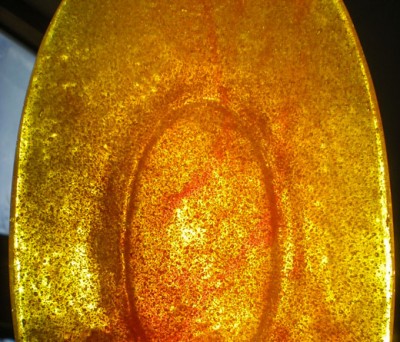imraslan wrote:Thank you Morgan. I was doing a letter from glass in a plaster mold. the sides touching the plaster had a very thin layer of plaster stuck on it with a rough surface. I have placed glass frits in the mold and fired it up. there is a side not touching the plaster which like you said was very shinny and ideally i wantd the sides touching the mold to be also of the same shine.
I have read and there are many ways to grind and polish, I only used rough then thin sand paper and it became very smooth but was matt and lost the shine. I tried tourching it but it cracked and then broke, however it became thiny

. actually this is the second question, is it normal to break if I used a tourch? and if it does then what is th best method to grind and polish to get a shinny finish.
I really love your work, very creative

. I see ur point where pate de verre being satin, what can be an alternative casting method for a clear sea through finish.
thanks allot for your help, appreciate if you let me know what are the best girnd and polish methods for pate de verre and alternative method for a shinny clear finish
Thanks. The transparency (clear) part of the finish comes from what type of glass you use, whether it's solid blocks of glass (billet) or crushed glass or powdered glass. Air is trapped between the pieces of glass when they melt in the mold, making bubbles, and the bubbles keep light from going straight through the piece, making it look less transparent. The smaller the pieces of glass, the more bubbles. The photo I posted shows pate de verre made with powdered glass. Here's another view of pate de verre that was made using all transparent glass powders:

When you shine strong light through it, you can see how many bubbles are there--that's what causes the translucent appearance. If you want a perfectly transparent piece, use larger chunks or billet. There is not much you can do to restore transparency except put the glass back in the mold and heat it for several hours at the top temperature. Even then, if the piece was made with smaller glass particles, it will still have bubbles and not be as transparent.
As Dee said, torching the glass to firepolish it creates uneven heating throughout the piece. Glass expands where it's heated, and so it cracks away from the cooler areas. It takes a lot of practice to heat a finished vessel uniformly enough in a torch so that it doesn't crack; it's usually easier to heat it in a kiln.
Glassy, shiny surfaces are generally formed two ways: By ensuring that the glass doesn't touch anything while it's soft (i.e., letting it firepolish), or by coldworking it back to a full shine. Wherever the glass is in contact with anything (mold, kilnshelf, etc), the finish won't be as shiny. That's one reason so many cast pieces have a satin or matte finish.

So...if you want your cast letters to be uniformly shiny, you need to put them in the kiln, without any mold around them, and firepolish them. It's not easy--the glass tends to soften and distort before it's fully polished. Usually you use a schedule that's somewhere between a slump and a full fuse--exactly what the schedule should be depends upon your kiln and what you're trying to polish. If you search for firepolish in this forum you should find information on how it's done.
